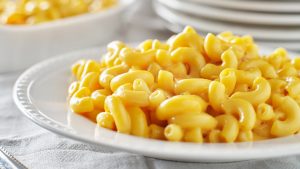We’re thrilled to inform you that the 2024 National Child Nutrition Conference offers an excellent opportunity for you to earn Continuing Professional Education Units (CPEUs) while immersing yourself in a world of learning and networking.
Read MoreThe USDA recently released a Final Rule that better aligns meal patterns in the CACFP, SFSP, and School Meals with the Dietary Guidelines for Americans.
Read MoreWhat can you do outside of meal service to prepare children for family style dining?
Read MoreAcross the nation, racial inequities have impacted access to federal nutrition programs for people of color. The report by D.C. Hunger Solutions aims to address how racial inequities contribute to hunger and poverty among residents of color in the District of Columbia and to lack of access to federal nutrition programs.
Read MoreAccording to a USDA report, one in every five children in the United States is food insecure, meaning that approximately 13 million children do not know where their next meal will come from. The CACFP provides quality meals to many of these children and helps working families protect their children against hunger. Read more about how CACFP contributes to food security.
Read MoreWe’re thrilled to inform you that the 2024 National Child Nutrition Conference offers an excellent opportunity for you to earn Continuing Professional Education Units (CPEUs) while immersing yourself in a world of learning and networking.
Read MoreThe National CACFP Sponsors Association is excited to introduce the newest group of scholarship winners for the 2024 National Child Nutrition Conference!
Read MoreCheck out these virtual events coming up at NCA!
Read More100 More Scholarships! February 7, 2024 While we have already awarded 15 scholarships to attend the National Child Nutrition Conference, April 22-26, we are thrilled to announce that we’re opening up applications for even more scholarships! We’ll be giving away up to 100 scholarships, which is over $50,000 dedicated to enhancing educational opportunities for the…
Read MoreCheck out these virtual events coming up at NCA!
Read MoreThe USDA recently released a Final Rule that better aligns meal patterns in the CACFP, SFSP, and School Meals with the Dietary Guidelines for Americans.
Read MoreAccording to a USDA report, one in every five children in the United States is food insecure, meaning that approximately 13 million children do not know where their next meal will come from. The CACFP provides quality meals to many of these children and helps working families protect their children against hunger. Read more about how CACFP contributes to food security.
Read MoreUSDA released a final rule that revises regulations to align the WIC food packages with the current Dietary Guidelines for Americans and to reflect recommendations from the National Academies of Science, Engineering, and Medicine while promoting nutrition security and equity and considering program administration.
Read MoreSince our last policy updated, there has been new legislation introduced, a proposed rule for serious deficiency released, as well as federal and state recognition of the CACFP. There have also been multiple pieces of USDA guidance and FRAC research published regarding the CACFP.
Read MoreOver 20 million children leave school each day unsure if they will have supper at home. There’s help for that. Afterschool programs can take advantage of the Child and Adult Care Food Program (CACFP), offered by the USDA,
Read MoreOn March 20, 2023, the Early Childhood Nutrition Improvement Act was introduced in the Senate by Senator Bob Casey (PA) This legislation would allow providers who are open for more than 8 hours to be reimbursed for an additional meal.
Read MoreEvery movement from bringing food to mouth, opening mouth, biting, moving tongue to chew food and then swallowing are all learned skills. Use this baby development resource to see how infant eating skills build over time.
Read MoreDownload this members-only resource on making homemade baby puree. You’ll discover tips and tricks, safety information and two recipes.
Read MoreDownload this free set of CACFP flashcards to introduce novel fruits and vegetables in your program.
Read MoreThis meal planning and food-buying guide from the USDA can help you take extra precautions and stay prepared for a pandemic.
Read MoreDownload and print this free full color infographic from the USDA on yogurt. It includes five fantastic yogurt recipes.
Read MoreDownload and print this free full color infographic from the USDA on turkey. It includes five fantastic turkey recipes.
Read MoreWhat can you do outside of meal service to prepare children for family style dining?
Read MoreWhat is family style dining in the CACFP?
Read MoreIs shelf-stable yogurt reimbursable in the CACFP?
Read MoreWhat is needed to serve quiche as part of a reimbursable meal?
Read MoreAre all soy beverages creditable in the CACFP?
Read MoreWhat is a cheese product, and is it creditable?
Read MoreThe Child and Adult Care Food Program has new creditable foods listed on the USDA Food Buying Guide! If you are new to the FBG, this interactive tool allows for easy display, search, and navigation of food yield information. In addition, users can compare yield information, create a favorite foods list, and access tools, such as the Recipe Analysis Workbook (RAW) and the Product Formulation Statement Workbook.
Read MoreThe Child and Adult Care Food Program community asked for more Spanish resources to be available on the National CACFP Sponsors Association website and we heard you! Available now in Spanish are more resources to help sponsors and providers with meal pattern requirements, best practices, and so much more!
Read MoreServing meals to young people year-round benefits children, families, and care providers. To do this, many providers transition from operating the USDA Child and Adult Care Food Program (CACFP) At-Risk Afterschool (ARAS) during the school year to the Summer Food Service Program (SFSP) while school is out. For an overview of the main differences between SFSP and CACFP ARAS, see the comparison chart below.
Read MoreNCA understands that the end of flexibilities will cause challenges for many CACFP sponsors and providers and we commend your continued commitment to providing nutritious meals and snacks to the children or adults in your care. In preparation for the end of the additional reimbursement, we have collected the following resources to help you successfully provide meals even if your available budget decreases.
Read MoreCDC created three new fact sheets for Early Care and Education (ECE) providers about Early Child Nutrition and Feeding. The fact sheets offer tips and best practices for supporting breastfeeding families, information about safe storage and handling of breastmilk, and strategies for introducing solid foods.
Read MoreAcross the nation, racial inequities have impacted access to federal nutrition programs for people of color. The report by D.C. Hunger Solutions aims to address how racial inequities contribute to hunger and poverty among residents of color in the District of Columbia and to lack of access to federal nutrition programs.
Read MoreWhen combined, the CACFP and Farm to Early Care Education (Farm to ECE) activities can have an extraordinary impact on children, child care providers, and local communities. FRAC’s report aims to support child care providers to access CACFP and utilize it for eligible Farm to ECE activities by highlighting the mutually beneficial synergy between these initiatives.
Read MoreThe CACFP is an indicator for state-level obesity prevention. The inclusion of the CACFP as an indicator for obesity-prevention shows that the CACFP is an important, recognized factor for proper development in the earliest stages of life.
Read MoreThe University of Colorado College of Nursing published their 2022 Annual Report on Achieving a State of Healthy Weight. The report determines how state regulations support obesity prevention in licensed ECE programs. It also highlights state successes and identifies opportunities for ECE regulations to improve support of obesity prevention in young children.
Read MoreA study was published in October 2023 by the Urban Institute to identify major gaps in the CACFP’s coverage and ability to reach children. The study specifically focused on CACFP eligibility for small home-based child care providers who are legally exempt from their state’s child care licensing requirements.
Read More







































